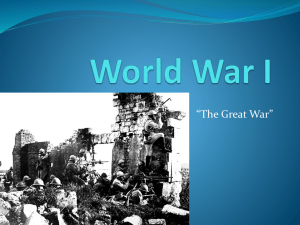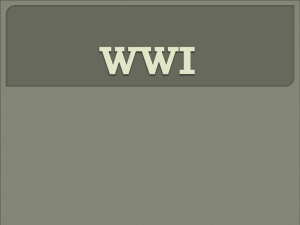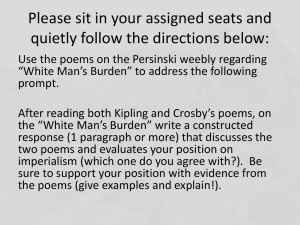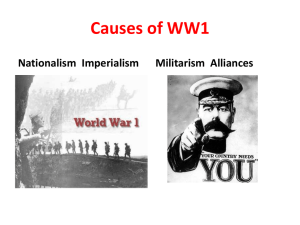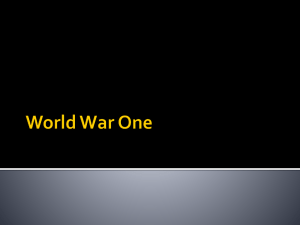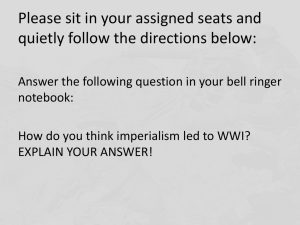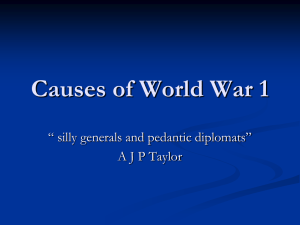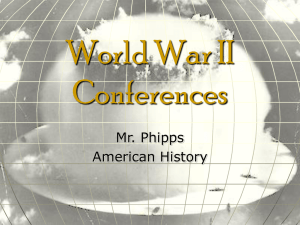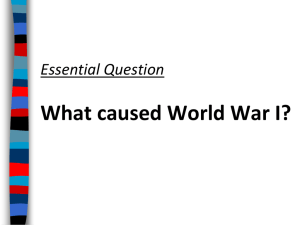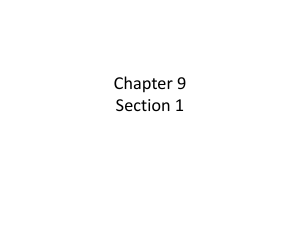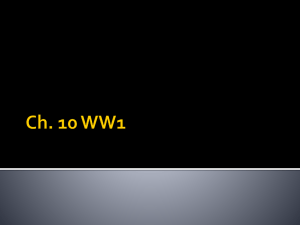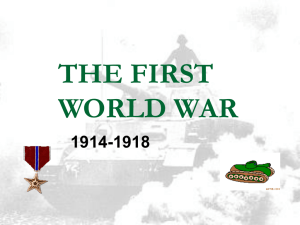World War I Power Point
advertisement
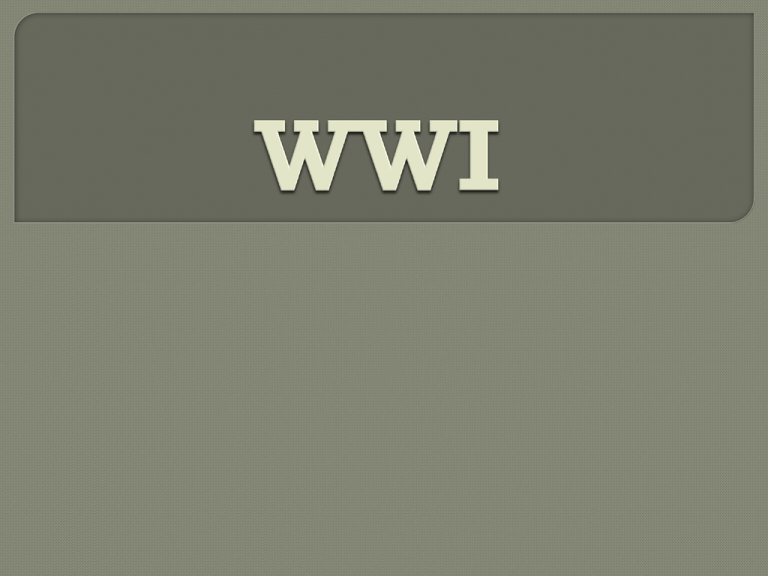
1st World War in history •Great War or War to End all War •Not called WWI until after WWII •Total war •Involved 60 nations and 6 continents Cost of War •$400 billion •$10 million dollars an hour 16 million deaths •First war of the Industrial Revolution…… New Weapons vs old tactics of fighting Imperialism- European powers were going to all parts of the world to gain land. Africa, Asia, The Pacific By 1910, the most desirable colonies had been taken. Germany envied France and Britain b/c they had the most richest colonies. They soon realized that the only way to get land in Africa was to take it away from the colonizers. European nations competing for colonies around the world…..Imperialism 2 forms- 1: to act in the country’s own national interest. Ex: Alsace-Lorraine-strip of land on the boarder of France and Germany. Had been taken by Germany in 1871 and France was expecting to gain it back. Germany did not want to give it up. This caused problems in their relationship. 2. The longing for an ethnic minority independence in a nation where there are many different/diverse groups. Ex: Austria-Hungary- Hungarians and German speaking Austrians governed millions of Czechs, Slovaks, Poles Italians, Romanians and Serbs. These different groups wanted their own independent self government and lands. This often caused conflict within the nation itself. Building up a nation’s military for war and giving them more power than the government. Austria-Hungary, France, Germany, Great Britain, Russia Spend large sums of money on new weapons and warships. All of these countries were preparing for war. Alliances •European nations began forming military alliances with one another to maintain a balance of power …….. Triple Alliance Central Powers Triple Entente Allied Powers Germany Austria-Hungary Empire Bulgaria Great Britain France Russia Assassination of Franz Ferdinand Franz Ferdinand’s funeral procession Garvillo Princip, a Serbian nationalist assassinated the Archduke. He was trying to gain allowances for his fellow Serbs who lived under Austrian rule. Archduke Franz Ferdinand and his family. Archduke was heir to the throne in the Austrian Hungarian Empire. His assassination June 28, 1914 eventually led to WWI. When the Archduke was assassinated, Bosnia along with Serbia were annexed to Austria-Hungary. Austria-Hungary was convinced Serbia has something to do with the killings. They used this excuse to declare war on Serbia on July 28, 1914. This set off the chain reaction of alliances throughout Europe. July 29, 1914- (Russia was Serbia’s protector) began mobilization. Germany demanded Russia stop. They didn’t. Germany declared war on Russia. Russia’s ally France declared war on Germany. Germany Great declares war on Belgium. Britain declared war on Germany. Quick sweep through France to knock the French out of the war then turn east and defeat Russia. Germany This is between France and Russia. plan was put in order to avoid fighting both countries at the same time. Germany had to pass through Belgium to get to France Belgium was neutral. Germany hoped Britain would stay out of the war. The invasion of Belgium brought Britain into the war. 1 week after the conflict started all of Europe’s great powers were involved. Central Powers Allies Germany Russia Austria-Hungary France Bulgaria Serbia Great Britain Archduke and Wife Assassinated Germany Demands Russia Stop Germany’s Schlieffen Plan Austria-Hungary Declares war on Serbia July 28, 1914 Russian’s ally France readies troops Britain Enters War after invasion of Belgium August 4, 1914 Russia Begins Mobilization July 29, 1914 Germany Declares war on Russia August 1,1914 Central Powers and Allies Formed Stalemate- Both sides can’t gain the advantage. Germany and France and Britain 1914 Ottoman Empire and Bulgaria join Central Powers Italy and Romania join Allies Central Powers Allies Germany Russia Austria-Hungary France Ottoman Serbia Bulgaria Empire Great Britain Italy Romania Machine guns and rapid fire artillery Air Planes Zeppelins Grenades Tanks Submarines Poison Gas Battle of Somme in 1916 British troops lost 20,000 troops in one day. Trench foot Contracted Constant No lice from rats fear man’s land Casualties (French had 1,000,000 casualties in first 3 months of war) Trench Warfare Some felt personally involved b/c 92 million were immigrants or children of immigrants. Germans Most and Irish for Central Powers Americans for Allies Wilson wanted Americans to remain neutral. •Panama Canal was completed in August of 1914 just a week before WWI began in Europe. •Woodrow Wilson became President in 1912. •Americans were shocked by the outbreak of war but…………..it was in Europe. •US was officially NEUTRAL American Neutrality- Influenced by trade Preparedness Movement- Be ready for war. Patriotic education (Propaganda) Peace Movement- Progressives, social reformers and women. (Women marching down streets proclaiming peace). 3 groups Isolationists- Stay out of war Interventionists- U.S. should intervene on side of Allies Internationalists- Get involved only to solve the problem and promote peace. Britain blockades Germany for its contraband. Later Britain took all of the goods that were supposed to go into Germany. (Food, cotton, medicine, gasoline) German response = blockade of Britain U-Boats- Britain and Germany competed to build the largest and strongest navy. Germany blockaded Britain by navy. Propaganda used by Britain to sway U.S. opinion. Lusitania- 128 Americans killed Germany agreed to stop blowing up passenger ships. March 24,1916 Sussex was sunk by Germans Killed 2 Americans Sussex Pledge- Germans would warn ships before they sank them. Wilson authorized banks to make a huge loan to the Allies. •May 7, 1915, the Germans sunk the Lusitania which was British passenger liner. •Germans believed it was carrying contraband (weapons) to the British. •Killed 1,198 civilians including 128 Americans. •U.S. and other countries outraged towards Germany because of “unrestricted submarine warfare”. •US believed the Germans had violated international law of targeting civilians Jan. 31, 1917 Germany informs U.S. that the Sussex pledge would be ended. Feb. 3 U.S. cuts off diplomatic ties with Germany. Zimmerman Note- Germany promises lost land to Mexico if they declare war on U.S. War Industries Board (Bernard Baruch) coordinated production and price controls Food Administration (Herbert Hoover) voluntary efforts to conserve food for soldiers Financing - Liberty Bonds America and the War Effort (p. 636) “Remember Your First Thrill of American Liberty” (p. 649) Committee on Public Information propaganda agency in America (George Creel) “do your bit” for the war Hate the Hun, Liberty Cabbage, Salisbury Steak, Can the Kaiser Espionage and Sedition Acts (1917-18) jail sentences for those critical of disloyal or abusive remarks toward US war effort Schenck v. United States (1919) “clear and present danger” - free speech could be limited Selective Service Act (1917) draft: 2.8 million draftees, 2.9 million volunteers Eventually 2 million were sent to Europe Blacks - 400,000 served, few officers Blacks hoped for service abroad = equal rights at home (not so) Women took mens jobs while men were “Over There” led to Nineteenth Amendment Mexicans - left Mexico (upheaval and revolution) and took jobs in American West Blacks - Great Migration to northern cities for job opportunities and to escape poverty Russian revolution and withdrawal (Treaty of Brest-Litovsk) allowed Germany to focus on Western front entirely Naval shipping losses = huge. Led to “Convoy System” and record ship construction American Expedition ary Force (AEF) General John J. Pershing First major action in spring 1918 German Counteroffensive Chateau-Thierry (2nd Battle of the Marne) Belleau Wood (June 1918) Meuse (river) Argonnes (forest) Offensive (Fall 1918) St. Mihiel November 11, 1918 Armistice (cease-fire) Map 22.2 U.S Participation on the Western Front, 1918 (p. 644) 50,000 Americans died in 1918 combat 1918 Influenza epidemic (worldwide) killed thousands of soldiers and millions of people around the globe 112,000 American fatalities from flu Paris and Palace of Versailles Big Four: • Woodrow Wilson (USA) • David Lloyd George (GBR) • Georges Clemenceau (FR) • Orlando Vittorio (IT) Russia excluded Defeated powers humiliated Wilson’s 14 points the major proposal To “make the world safe for democracy” #1-5 - international law recommendations #6-13 - European boundary restructure #14 - League of Nations Map 22.3 The Great Migration and Beyond (p. 650)
